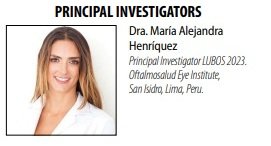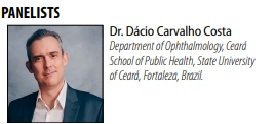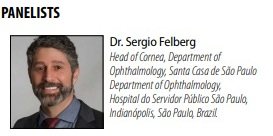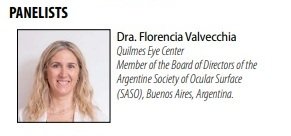Consenso Latino-americano sobre Lubrificantes Oculares e Olho Seco (LUBOS)
DOI:
https://doi.org/10.70313/2718.7446.v17.nS1Eng.383Palavras-chave:
filme lacrimal, superfície ocular, olho seco, lágrimas artificiais, lubrificantes oculares, consenso, América LatinaResumo
O fluido lacrimal possui uma composição com-plexa que lhe permite cumprir múltiplas funções, como funções ópticas, lubrificantes, imunológicas, endócrinas e neurotróficas, essenciais para a saúde visual.A alteração dos seus componentes, tanto em qua-lidade quanto em quantidade, afetará a sua home-ostase, afetando também a superfície ocular, deter-minando uma patologia denominada “olho seco”.O olho seco tem uma elevada prevalência global, que por sua vez está aumentando devido a aspec-tos ambientais (principalmente uso de telas) e ao aumento da expectativa de vida.Existem vários produtos para o seu tratamento, mas os lubrificantes —genericamente conhecidos como “lágrimas artificiais”—são essenciais. Existe uma grande variedade de formulações de lubrifi-cantes com diferentes indicações que, se utilizadas de forma adequada e de acordo com o tipo e grau de gravidade do olho seco, permitem uma perso-nalização eficaz do tratamento.Considerando a complexidade e relevância deste tema, foi formado o Grupo Latino-Americano de Estudos sobre Lubrificantes e Olho Seco (LUBOS). O presente trabalho é um consenso feito com o objetivo de criar um algoritmo diagnóstico e tera-pêutico para olho seco, focado no uso adequado de lubrificantes e orientado de forma prática para o oftalmologista geral
Referências
Nasa P, Jain R, Juneja D. Delphi methodology in healthcare research: how to decide its appro¬priateness. World J Methodol 2021; 11: 116-129.
Gattrell WT, Hungin AP, Price A et al. AC¬CORD guideline fot reporting consensus-based methods in biomedical research and clinical practice: a study protocol. Res Integr Peer Rev 2022, 7: 3.
Baker A, Young K, Potter J, Madan I. A re¬view of grading system for evidence-based guidelines produced by medical specialties. Clin Med (Lond) 2010; 10: 358-363.
Craig JP, Nelson JD, Azar DT et al. TFOS DEWS II report executive summary. Ocul Surf 2017; 15: 802-812.
Lemp MA. Report of the National Eye Insti¬tute/Industry workshop on clinical trials in dry eyes. CLAO J 1995; 21: 221-332.
The definition and classification of dry eye disease: report of the Definition and Classifi¬cation Subcommittee of the International Drye Eye Workshop (2007). Ocul Surf 2007; 5: 75-92.
Craig JP, Nichols KK, Akpek EK et al. TFOS DEWS II definition and classification report. Ocul Surf 2017; 15: 276-283.
Tsubota K, Yokoi N, Shimazaki J et al. New perspectives on dry eye definition and diagno¬sis: a consensus report by the Asia Dry Eye So¬ciety. Ocul Surf 2017; 15: 65-76.
Akpek EK, Amescua G, American Acade¬my of Ophthalmology Preferred Pactice Pattern Cornea and External Disease Panel et al. Dry eye syndrome Preferred Practice Pattern®. Oph¬thalmology 2019; 126: P286-P334.
Tsubota K, Pflugfelder SC, Liu Z et al. Defin¬ing dry eye from a clinical perspective. Int J Mol Sci 2020 4; 21: 9271.
Rodrigues-Garcia A, Babayan-Sosa A, Ramírez-Miranda A et al. A practical appoach to severity classification and treatment of dry eye disease: a proposal from the Mexican Dry Eye Disease Expert Panel. Clin Ophthalmol 2022; 16: 1331-1355.
Craig JP, Alves M, Wolffsohn JS et al. TFOS lifestyle report introduction: a lifestyle epidem¬ic-ocular surface disease. Ocul Surf 2023; 28: 304-309.
Pflugfelder SC. Antiinflammatory therapy for dry eye. Am J Ophthalmol 2004; 137: 337- 342.
Shimazaki J. Definition and diagnosis of dry eye 2006. Atarashii Ganka 2007; 24:181-184.
Hyon JY, Kim HM, Korean Corneal Disease Study Group et al. Korean guidelines for the di¬agnosis and management of dry eye: develop¬ment and validation of clinical efficacy. Korean J Ophthalmol 2014; 28: 197-206.
Liu, Z. The preliminary recommendations on the name and classification of dry eye. Chin J Eye Otolaryngol 2004; 3: 4-5.
The Chinese Corneal Society. The consen¬sus on clinical diagnosis and treatment of dry eye. Chin J Ophthalmol 2013; 49: 73-75.
Shimazaki J. Definition and diagnostic cri¬teria of dry eye disease: historical overview and future directions. Invest Ophthalmol Vis Sci 2018; 59: DES7-DES12.
Merriam-Webster Dictionary 2016. http:// www.merriam-webster.com
Kannan RJ, Das S, Shetty R et al. Tear pro¬teomics in dry eye disease. Indian J Ophthalmol 2003; 71: 1203-1214.
Jacson CJ, Gundersen KG, Tong L, Utheim TP. Dry eye disease and proteomics. Ocul Surf 2022; 24: 119-128.
Ohashi Y, Ishida R, Kojima T et al. Abnor¬mal protein profiles in tears with dry eye syn¬drome. Am J Ophthalmol 2003; 136: 291-299.
Pflugfelder SC, Jones D, Ji Z et al. Altered cy¬tokine balance in the tear fluid and conjunctiva of patients with Sjögren’s syndrome keratocon¬junctivitis sicca. Curr Eye Res 1999; 19: 201-211.
Enríquez-de-Salamanca A, Castellanos E, Stern ME et al. Tear cytokine and chemokine analysis and clinical correlations in evapora¬tive-type dry eye disease. Mol Vis 2010; 16: 862- 873.
Solomon A, Dursun D, Liu Z et al. Pro- and anti-inflammatory forms of interleukin-1 in the tear fluid and conjunctiva of patients with dry-eye disease. Invest Ophthalmol Vis Sci 2001; 42: 2283-2292.
Yoon KC, Jeong IY, Park YG, Yang SY. Inter¬leukin-6 and tumor necrosis factor-alpha levels in tears of patients with dry eye syndrome. Cor¬nea 2007; 26: 431-437.
Tishler M, Yaron I, Geyer O et al. Elevated tear interleukin-6 levels in patients with Sjögren syndrome. Ophthalmology 1998; 105: 2327- 2379.
Danjo Y, Lee M, Horimoto K, Hamano T. Oc¬ular surface damage and tear lactoferrin in dry eye syndrome. Acta Ophthalmol (Copenh) 1994; 72: 433-437.
Navone R, Lunardi C, Gerli R et al. Identifi¬cation of tear lipocalin as a novel autoantigen tar¬get in Sjögren’s syndrome. J Autoimmun 2005; 25: 229-234.
Yamada M, Mochizuki H, Kawai M et al. De¬creased tear lipocalin concentration in patients with meibomian gland dysfunction. Br J Ophthal¬mol 2005; 89: 803-805.
Schlegel I, De Goüyon Matignon de Pon¬tourade CMF, Lincke JB et al. The human ocu¬lar surface microbiome and its associations with the tear proteome in dry eye disease. Int J Mol Sci 2023; 24: 14091.
Zhao H, Jumblatt JE, Wood TO, Jumblatt MM. Quantification of MUC5AC protein in hu¬man tears. Cornea 2001; 20: 873-877.
Virtanen T, Konttinen YT, Honkanen N et al. Tear fluid plasmin activity of dry eye patients with Sjögren’s syndrome. Acta Ophthalmol Scand 1997; 75: 137-141.
Aho VV, Nevalainen TJ, Saari KM. Group IIA phospholipase A2 content of basal, nonstimulated and reflex tears. Curr Eye Res 2002; 24: 224-227.
Chen D, Wei Y, Li X et al. sPLA2-IIa is an in¬flammatory mediator when the ocular surface is compromised. Exp Eye Res 2009; 88: 880-888.
Jung GT, Kim M, Song JS et al. Proteomic analysis of tears in dry eye disease: a prospective, double-blind multicenter study. Ocul Surf 2023; 29: 68-76.
Koduri MA, Prasad D, Pingali T et al. Optimi¬zation and evaluation of tear protein elution from Schirmer’s strips in dry eye disease. Indian J Oph¬thalmol 2023; 71: 1413-1419.
Peral A, Carracedo G, Acosta MC et al. In¬creased levels of diadenosine polyphosphates in dry eye. Invest Ophthalmol Vis Sci 2006; 47: 4053- 4058.
Potvin R, Makari S, Rapuano CJ. Tear film os¬molarity and dry eye disease: a review of the liter¬ature. Clin Ophthalmol 2015; 9: 2039-2047.
Bron AJ, de Paiva CS, Chauhan SK et al. TFOS DEWS II pathophysiology report. Ocul Surf 2017; 15: 438-510.
Sheppard JD, Nichols KK. Dry eye disease associated with meibomian gland dysfunction: focus on tear film characteristics and the ther¬apeutic landscape. Ophthalmol Ther 2023; 12: 1397-1418.
Lam SM, Tong L, Reux B et al. Lipidom¬ic analysis of human tear fluid reveals struc¬ture-specific lipid alterations in dry eye sín¬drome. J Lipid Res 2014; 55: 299-306.
Barbosa EB, Tavares CM, da Silva DFL et al. Characterization of meibomian gland dysfunc¬tion in patients with rosacea. Arq Bras Oftal¬mol 2023; 86: 365-371.
Wang LX, Deng YP. Androgen and meibo¬mian gland dysfunction: from basic molecular biology to clinical applications. Int J Ophthalmol 2021; 14: 915-922.
Fischer FH, Wiederholt M. Human precor¬neal tear film pH measured by microelectrodes. Graefes Arch Clin Exp Ophthalmol 1982; 218: 168-170.
Downloads
Publicado
Como Citar
Edição
Secção
Licença
Direitos de Autor (c) 2024 Consejo Argentino de Oftalmología

Este trabalho encontra-se publicado com a Licença Internacional Creative Commons Atribuição-NãoComercial-SemDerivações 4.0.
Con esta licencia no se permite un uso comercial de la obra original, ni la generación de obras derivadas. Las licencias Creative Commons permiten a los autores compartir y liberar sus obras en forma legal y segura.








































